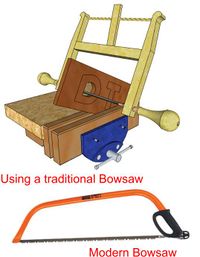Bowsaw: Difference between revisions
From DT Online
m (Capitalise Teeth per Inch) |
m (Changed TPI link) |
||
| Line 4: | Line 4: | ||
Traditional Bowsaws consist of a wooden frame and were used for cutting curved shapes in thicker materials than for a '''[[Coping saw]]''' and '''[[Fretsaw]]''' but their use in D&T workshops has been much replaced by a '''[[Bandsaw]]''' or '''[[Jigsaw]]'''. | Traditional Bowsaws consist of a wooden frame and were used for cutting curved shapes in thicker materials than for a '''[[Coping saw]]''' and '''[[Fretsaw]]''' but their use in D&T workshops has been much replaced by a '''[[Bandsaw]]''' or '''[[Jigsaw]]'''. | ||
Typically, blades are about 250 to 300mm long and from 10 to 24 | Typically, blades are about 250 to 300mm long and from 10 to 24 teeth per inch ''[[Teeth per Inch|(TPI)]]''. The blade is kept in tension by twisting a loop of cord by means of a length of wood passing through it to create a [http://en.wikipedia.org/wiki/Tourniquet#History ''tourniquet''] or [http://en.wikipedia.org/wiki/Turnbuckle ''turnbuckle''] type action. | ||
They are normally used as shown with both hands gripping one of the handles - two handles are provided to allow the blade to be turned and cut in different directions. | They are normally used as shown with both hands gripping one of the handles - two handles are provided to allow the blade to be turned and cut in different directions. | ||
Revision as of 12:35, 23 October 2014
Bowsaws are a type of framesaw. Modern Bowsaws have a metal tube frame with very coarse blades about 600mm long. They are used mainly for rough cutting of logs and shrubbery with few applications within a D&T workshop,
Traditional Bowsaws consist of a wooden frame and were used for cutting curved shapes in thicker materials than for a Coping saw and Fretsaw but their use in D&T workshops has been much replaced by a Bandsaw or Jigsaw.
Typically, blades are about 250 to 300mm long and from 10 to 24 teeth per inch (TPI). The blade is kept in tension by twisting a loop of cord by means of a length of wood passing through it to create a tourniquet or turnbuckle type action.
They are normally used as shown with both hands gripping one of the handles - two handles are provided to allow the blade to be turned and cut in different directions.
